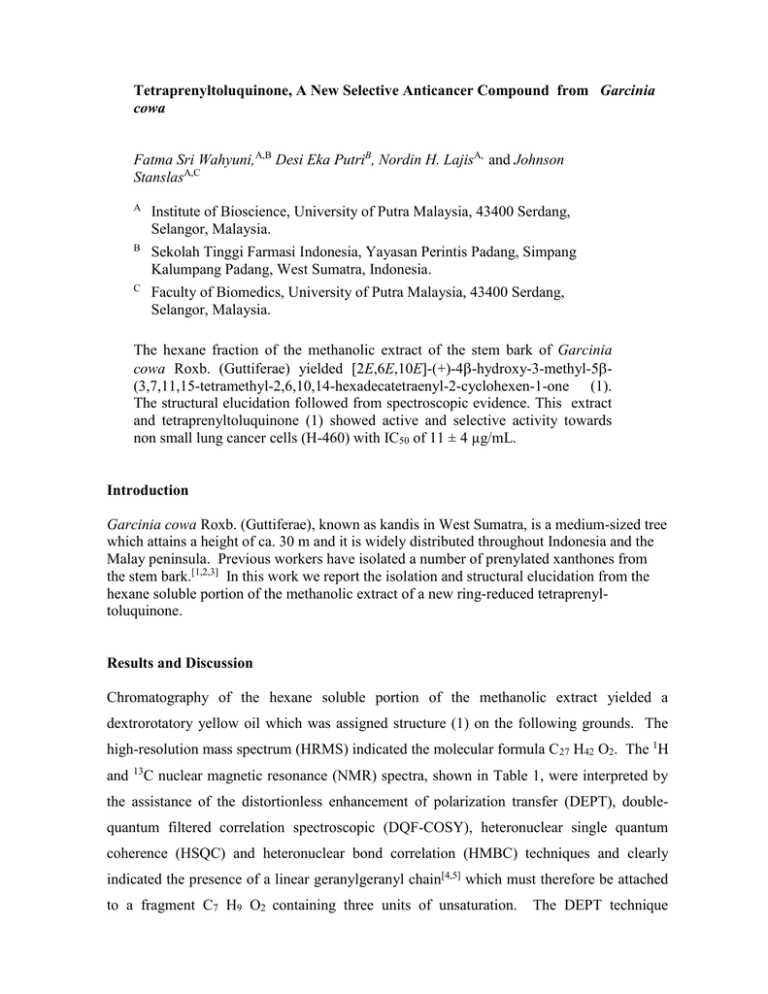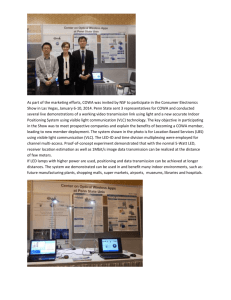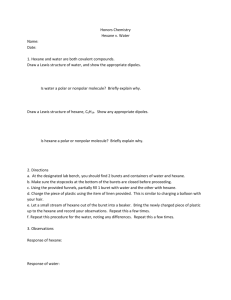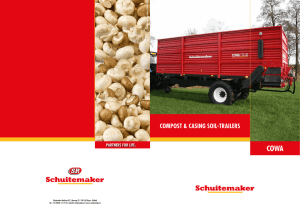Publikasi laporan hibah ayu
advertisement

Tetraprenyltoluquinone, A New Selective Anticancer Compound from Garcinia cowa Fatma Sri Wahyuni,A,B Desi Eka PutriB, Nordin H. LajisA, and Johnson StanslasA,C A Institute of Bioscience, University of Putra Malaysia, 43400 Serdang, Selangor, Malaysia. B Sekolah Tinggi Farmasi Indonesia, Yayasan Perintis Padang, Simpang Kalumpang Padang, West Sumatra, Indonesia. C Faculty of Biomedics, University of Putra Malaysia, 43400 Serdang, Selangor, Malaysia. The hexane fraction of the methanolic extract of the stem bark of Garcinia cowa Roxb. (Guttiferae) yielded [2E,6E,10E]-(+)-4-hydroxy-3-methyl-5(3,7,11,15-tetramethyl-2,6,10,14-hexadecatetraenyl-2-cyclohexen-1-one (1). The structural elucidation followed from spectroscopic evidence. This extract and tetraprenyltoluquinone (1) showed active and selective activity towards non small lung cancer cells (H-460) with IC50 of 11 ± 4 µg/mL. Introduction Garcinia cowa Roxb. (Guttiferae), known as kandis in West Sumatra, is a medium-sized tree which attains a height of ca. 30 m and it is widely distributed throughout Indonesia and the Malay peninsula. Previous workers have isolated a number of prenylated xanthones from the stem bark.[1,2,3] In this work we report the isolation and structural elucidation from the hexane soluble portion of the methanolic extract of a new ring-reduced tetraprenyltoluquinone. Results and Discussion Chromatography of the hexane soluble portion of the methanolic extract yielded a dextrorotatory yellow oil which was assigned structure (1) on the following grounds. The high-resolution mass spectrum (HRMS) indicated the molecular formula C27 H42 O2. The 1H and 13C nuclear magnetic resonance (NMR) spectra, shown in Table 1, were interpreted by the assistance of the distortionless enhancement of polarization transfer (DEPT), doublequantum filtered correlation spectroscopic (DQF-COSY), heteronuclear single quantum coherence (HSQC) and heteronuclear bond correlation (HMBC) techniques and clearly indicated the presence of a linear geranylgeranyl chain[4,5] which must therefore be attached to a fragment C7 H9 O2 containing three units of unsaturation. The DEPT technique indicated that this fragment contained a ketone (C 198.99), a tertiary vinylic carbon (C 126.44), a quaternary vinylic carbon (C 161.14), a tertiary carbon (C 73.09) presumably attached to a hydroxy group, a tertiary carbon (C 43.47), a methylene group (C 41.06) and a methyl group (C 20.30). The infrared spectrum of the new compound indicated the presence of a hydroxyl function (max 3435 cm-1) and an -unsaturated ketone (max 1653 cm-1) in keeping with the 13C NMR spectrum. These data suggested that the fragment C7 H9 O2 was -methyl--unsaturated cyclohexenone substituted with a geranylgeranyl side chain and a hydroxy group. The tertiary vinylic carbon (C 126.44) was associated with a broad singlet at H 5.84 as shown by the HSQC technique so that it can be assigned to C(). The quaternary vinylic carbon (C 161.14) was deduced from the HMBC technique to be coupled (2 bonds) to the protons of a methyl group (H 2.02, C 20.38) so that this carbon is C(). The tertiary carbon (C 73.09, H 4.09), by application of the HMBC technique, was deduced to be coupled (3 bonds) to the methyl group protons (H 2.02) and to the vinyl proton (3 bonds) at H 5.80 so that this carbon is C(). Carbon C() was also coupled (3 bonds) to a proton at H 2.35 which is attached (HSQC) to C(1') of the geranylgeranyl chain which must therefore be attached to C(). This compound was elucidated as structure (1).[6] Methanol extracts and tetraprenyltoluquinol isolated from the stem bark of Garcinia cowa extract showed active and selective activity towards non small lung cancer cells (H460) with IC50 of 11 ± 4 µg/mL. [7] Experimental General directions have been given previously.[8] The 600 MHz 1NMR spectrum was recorded on a Bruker AV-600 instrument. Extraction and Isolation of Compounds from the bark of Garcinia cowa The stem bark of Garcinia cowa was collected in February 2006 at Sarasah Bonta, Harau Valley, 50 Kota District, West Sumatra at an altitude of 500m. A voucher specimen (DR-180) was identified by Dr Rusjdi Tamin and is deposited in the herbarium at Universitas Andalas. 2 Ground air-dried stem bark (5 kg) was percolated with hexane (10 L) followed by dichloromethane (10 L). The extracts were evaporated to dryness under reduced pressure and the dark mass (17.12 g, hexane) and (212 g, dichloromethane) Isolation of [2E,6E,10E]-(+)-4 -hydroxy-3-methyl-5 -(3,7,11,15-tetramethyl-2,6,10,14hexadecatetraenyl-2-cyclohexen-1-one 1 A portion (60.0 g) of the hexane extract was chromatographed over a column of silica gel with increasing amounts of ethyl acetate in hexane as eluent. Further purification was achieved using radial chromatography with the same eluent. This process yielded [2E,6E,10E]-(+)-4-hydroxy-3-methyl-5-(3,7,11,15-tetramethyl-2,6,10,14-hexadecatetraenyl-2-cyclohexen-1-one 1 (4g) as a yellowish oil. High-resolution FABMS [M+H]+• found: 399.3263 C27 H43 O2 requires m/z 399.3359. []26 D +50.0° (c,10.0, CHC13). EIMS: m/z 398 [M]+• (11%), 355(2), 329(2), 205(10), 161(10), 149(12), 138(11), 137(24), 136(18), 135(20), 133(12), 125(64), 124(16), 123(17), 122(11) 121(24), 108(32), 106(18), 104(13), 69(100). max/nm (MeOH) 230 ( 11,000). max/cm-1 (film) 3435, 3310, 2980, 2925, 2860, 1653, 1437, 1377, 1111, 1008, 886, 667. Cytotoxic assay ( MTT Assay) Cells will be attached by incubat suspensiocells (180 ul in each well axcept blank) for over night. Varying concentrations of the plant extracts will be prepared from the stock solutions by serial dilution (10-fold dilution start from 100 ug, 10 ug, 1 ug, 0.1 ug) in RPMI1640 to give a volume of 200 ul in each well of microtiter plate (96-well). The assay for each concentration of extract will be performed in quarted and the culture plate will be kept at 37 0 C with 5 % (v/v) CO2 for 4 days. After 96 hours of incubation, 50 ul of 0.2 % w/v MTT will be dissolved in phosphate buffer saline, will be added to each well and allowed to incubate for a further 4 hours. After 4 hours incubation, discard all supernatant. Subsequently, 100 ul DMSO will be added to each well and vigorously mixed to dissolve the formazan crystals. Absorbance values at 570 nm will be measured with a microplate reader. Cytotoxicity will be expressed as IC50 , i.e. the concentration to reduce the absorbance of treated cells by 50% with reference to the control (untreated cells). [9] 3 Acknowledgements We thank Dr Rusjdi Tamin for the identification of the plant material. Department of Education, Republic of Indonesia is thanked for financial support under Hibah Bersaing XIV. References [1] [2] [3] [4] [5] [6] H.-H. Lee, H.-K. Lee, Phytochemistry, 1976, 15, 2038. K. Likhitwitayawuid, T. Phandungchareon, C. Mahidol, S. Ruchirawat, Phytochemistry, 1997, 45, 1299. K. Likhitwitayawuid, T. Phandungchareon, J. Krungkrai, Planta Medica, 1998, 64, 70. V. Amico, F. Cunsolo, M. Piatelli, G. Ruberto, Phytochemistry, 1985, 24, 1047. M. D’Ambrosio, A. Guerriero, D. Fabbri, F. Pietra, Helv. Chim. Acta, 1986, 69, 1581. Fatma Sri Wahyuni, N.H.Lajis, J.Stanslas, D.A.I.Ali, K.Shaari and Dachriyanus, 14th Indonesian National Symposium on Natural Products Chemistry, Bandung,16-17th December 2004. [7] Fatma Sri Wahyuni, Lindsay T. Byrne, Dachriyanus, Roza Dianita, Junuarty Jubahar, Nordin H. Lajis and Melvyn V. Sargent, Aust. J. Chem., 2004, 57, 223-226. [8] R. W. Baker, Z. Brkic, M. V. Sargent, B. W. Skelton, A. H. White, Aust. J. Chem., 2000, 53, 925. [9] Shahan, T.A., P.D. Siegel, W.G. Sorenson, W.G. Kuschner, and D.M. Lewis, Journal of Immunological Methods, 1994,175, 181-187. H 3 2 OH 4 5 1' 16' 5' 2' 3' 4' 9' 6' 7' 8' 13' 10' 11' 12' 14' 15' 1 O (1) 4 Table 1. NMR data for cyclohexenone (1) in CDC13 Atoms 1 2 3 3-Me 4 5 6 C(125MHz) 198.99 126.44 164.14 20.38 73.07 43.47 41.06 1 30.55 2 3 120.52 138.16 4,8,12 5,9,13 39.75 39.60 39.55 26.64 26.49 26 .41 124 .28 124 .06 123 .76 135 .20 134 .78 131.07 6,10,14 7,11 15 16 15-Me 7-Me, 11-Me 3-Me OH H(600MHz,Eu(fod)3) H (500 MHz) mult., coupling constants 6.34, brs, Wh/2 7.0 Hz 5.84 2.23 4.50, brt, J ca. 5.5 Hz, Wh/2 18.0 Hz 2.45, m, Wh/2 27.0 Hz 2.68, dd, J6ax,6eq 16.0, J6ax,5ax 12.5 Hz 3.07, dd, J6eq,6ax 16.0, J6eq,5ax 2.5 Hz 2.30, ddd, J1,1 14.0, J1,2 7.3, J1,5 6.5 Hz 2.54, ddd, J1,1 14.0, J1,2 7.3, J1,5 5.5 Hz 5.30, brt, J2,1 7.3 Hz 2.04 4.14 2.10 2.10 2.51 2.10 2.35 5.20 1.96 – 2.14, m 5.10 m 5.09 17.55 25.56 15.93 15.87 16.14 2.84, brs, Wh/2 19.5 Hz 1.64, d, J 1.1 Hz 1.60, s, 6H, Wh/2 3.5 Hz 1.59, d, J 1.1 Hz 1.67,d, J 1.1 Hz 3.11, brs, Wh/2 14.0 Hz 5



